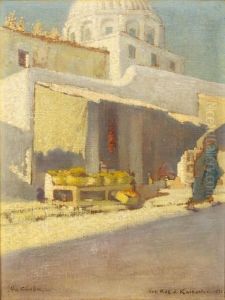Alexandre Cuvelier Paintings
Alexandre Cuvelier was a French landscape painter born on November 16, 1795, in the town of Douai, France. He was part of the Barbizon school, a group of artists who veered away from the formal traditions of landscape painting and sought inspiration from nature itself, often working directly from the landscape. This movement was named after the village of Barbizon near the Forest of Fontainebleau, where these artists gathered. Cuvelier was influenced by his contemporaries and predecessors, such as Camille Corot and Théodore Rousseau, both of whom were instrumental in the development of landscape painting in the 19th century.
Cuvelier's works are characterized by their tranquil, pastoral scenes and a soft, earthy palette that reflects the natural tones of the French countryside. His landscapes often included elements such as rustic buildings, woodland scenes, and agricultural workers, capturing the essence of rural life. He was skilled at portraying the effects of light and atmosphere, which added a sense of realism and immediacy to his paintings.
Despite his association with the Barbizon school, Alexandre Cuvelier did not achieve the same level of fame as some of his contemporaries. Nonetheless, his contributions to landscape painting were significant, providing a link between the neoclassical landscapes of the earlier 19th century and the more expressive, plein-air approach of the Barbizon painters. Cuvelier's work served as an inspiration for the next generation of artists, including the Impressionists, who would take the practice of painting in the outdoors to new heights.
Alexandre Cuvelier died on July 1, 1871, in Paris. Today, his paintings can be found in various art museums and collections, where they are appreciated for their contribution to the landscape genre and the Barbizon school's legacy. Although not as well-known as some of his peers, Cuvelier remains an important figure for his role in the transition towards modern landscape painting.
